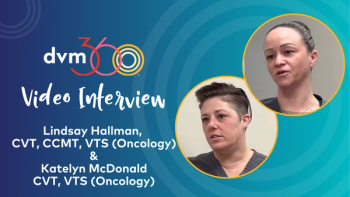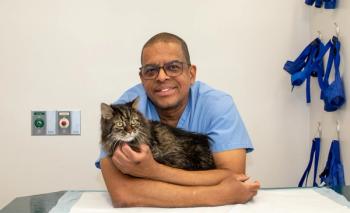
- dvm360 January-February 2025
- Volume 56
- Issue 1
- Pages: 26-27
Toothaches and triumphs
A veterinarian learns from his dental care journey
I was captivated by dentistry soon after attending my first dental wet lab in 1986. One of the best talks I remember at our annual veterinary dental forum was given by a boarded veterinary dentist, who shared blunders he made along the way to becoming better. I hope you can learn from some of my slipups and solutions.
Ineffectiveness of pulse therapy against biofilms
The use of pulse antibiotic therapy for oral infections is now considered inappropriate. In the 1990s, I worked with another veterinarian to spread the word about using pulse therapy, prescribing a dental antibiotic the first 5 days of the month to treat periodontal disease. The recommendation caught on like wildfire.
Unfortunately, the most significant pitfall of pulse antibiotic therapy in oral infections is its ineffectiveness against biofilms. A dental antibiotic is prescribed for the first 5 days of the month. Pulse therapy is unlikely to achieve the sustained high concentrations needed to penetrate these biofilms effectively. It fails to address the primary cause of periodontal disease, which requires mechanical plaque removal—systemic antibiotics should only be recommended for specific cases, such as patients with compromised immune systems.
Procedural oversights
Incomplete charting
Early in my dental career, I learned a crucial lesson about the importance of comprehensive examinations. Failing to conduct a meticulous tooth-by-tooth assessment and maintain detailed charts resulted in overlooked pathologies and missed opportunities to enhance patient care. This experience highlighted the critical nature of thorough documentation in dentistry. Over time, I have come to appreciate the significant advantages of electronic dental charting over traditional paper methods. Electronic charting offers several key benefits:
- Cloud-based accessibility: Patient records are securely stored in the cloud, allowing easy access during future dental visits, regardless of location.
- Improved accuracy: Electronic systems often include built-in checks and prompts, reducing the likelihood of errors or omissions in charting.
- Enhanced data analysis: Digital records facilitate easier patient history tracking,
treatment updates, and viewing of overall oral health trends. - Integration capabilities: Electronic charts can seamlessly connect with other dental technologies, such as imaging systems and practice management software.
- Better patient communication: Visual representations and digital charts can be easily shared with patients, improving their understanding of their oral health status and treatment plans.
By embracing electronic dental charting, we can significantly improve our ability to provide patients with comprehensive, consistent, high quality care (Figure 1).
Improper mouth gags
Spring-loaded mouth gags can cause temporomandibular joint damage, decreased cerebral blood flow, and blindness, especially in cats (Figure 2). A better option is cutting previously used endotracheal tubes placed between the canine teeth. In cats, the maximum size is 42 mm (Figures 3a-3b).
Extraction errors
Separated tooth roots during extraction can occur secondary to excessive force and inadequate alveolar bone removal, creating root fragments. Unless addressed, these can lead to ongoing pain and infection. To avoid this:
- Ensure instruments are sharpened before each extraction case (Figure 4).
- Remove the crown before removing the roots (Figures 5a-5c).
- If you choose not to use the crown removal technique, create a full-thickness flap that extends beyond the mucogingival junction. Use a sharpened periosteal elevator (flat Molt 2/4) to reflect the flap carefully (Figures 6a-6b).
- To section multirooted, teeth start at the furcation before extracting, even if the tooth is mobile.
- Remove adequate buccal bone before elevating.
- Use a luxator before an elevator to partially excise the periodontal ligament attachment.
Incomplete alveoloplasty
Failing to smooth sharp alveolar margin after extraction can lead to delayed healing and discomfort for the patient. After the tooth is delivered from its alveolus, a diamond-encrusted football dental bur can smooth the sharp alveolar crest (Figure 7). Before closing the flap over the extraction site, digitally palpate for any remaining sharp edges.
Postprocedure complications
Suture dehiscence
Flap closure with excessive tension after extractions can lead to wound breakdown. In most cases, when dehiscence occurs, the exposure heals through contraction and epithelialization (Figures 8a-8b).
Lip entrapment
Removing the protrusion of the dental alveolus after maxillary canine extraction in cats can cause lip entrapment and trauma. If this occurs, either extraction or crown reduction and restoration of the mandibular canine will eliminate the entrapment (Figures 9a-9b).
Incomplete removal of oral masses
When excising oral tumors, failing to achieve adequate margins can lead to rapid recurrence. Here is the solution:
- Obtain preoperative imaging (CT or MRI) for proper surgical planning.
- Plan 0.5- to 1-cm clean surgical margins in all directions for benign oral tumors and at least 2-cm clean margins for malignant tumors (Figures 10a-10b).
- Consider adjunctive treatments (radiation, chemotherapy) for high-grade tumors.
Oronasal fistula formation
Creating an oronasal communication is a complication during maxillary extractions, especially canine teeth. To avoid oronasal fistula formation, design a large flap that can be closed without tension and use careful elevation techniques to prevent excessive force (Figures 11a-11c).
The path to improvement
Successful outcomes in veterinary dentistry require knowledge, skill, and attention to detail. Continuous education, practice, and a willingness to learn from our mistakes are crucial. Quality control measures, such as regular case reviews, will help identify areas for improvement.
Approach each case thoroughly and commit to providing the best possible care. Minimize errors and improve outcomes in veterinary dental procedures by staying current with the latest techniques (subscribe to the Journal of Veterinary Dentistry), invest in proper equipment, and continually refine skills. Our goal as veterinary dental professionals is to enhance the quality of life for our patients through excellent oral health care. By learning from our mistakes and constantly striving for improvement, we can achieve this goal and advance the field of veterinary dentistry
Jan Bellows, DVM, DAVDC, DABVP (Canine, Feline), FAVD, received his doctorate in veterinary medicine from Auburn University in Alabama. After completing an internship at the Animal Medical Center in New York, New York, he returned to Florida, where he practices companion animal medicine surgery and dentistry at All Pets Dental in Weston.
Articles in this issue
9 months ago
Relief practice allows veterinarians to thrive10 months ago
Managing canine oral tumors10 months ago
Understanding anticipatory grief in pet owners10 months ago
Not reinventing the wheel—rethinking it!10 months ago
Power up your dental conversations10 months ago
Managing dystocia with surgery10 months ago
The economics of dental care10 months ago
Hemoperfusion for acute toxin ingestion12 months ago
Managing canine weight with a diet planNewsletter
From exam room tips to practice management insights, get trusted veterinary news delivered straight to your inbox—subscribe to dvm360.






